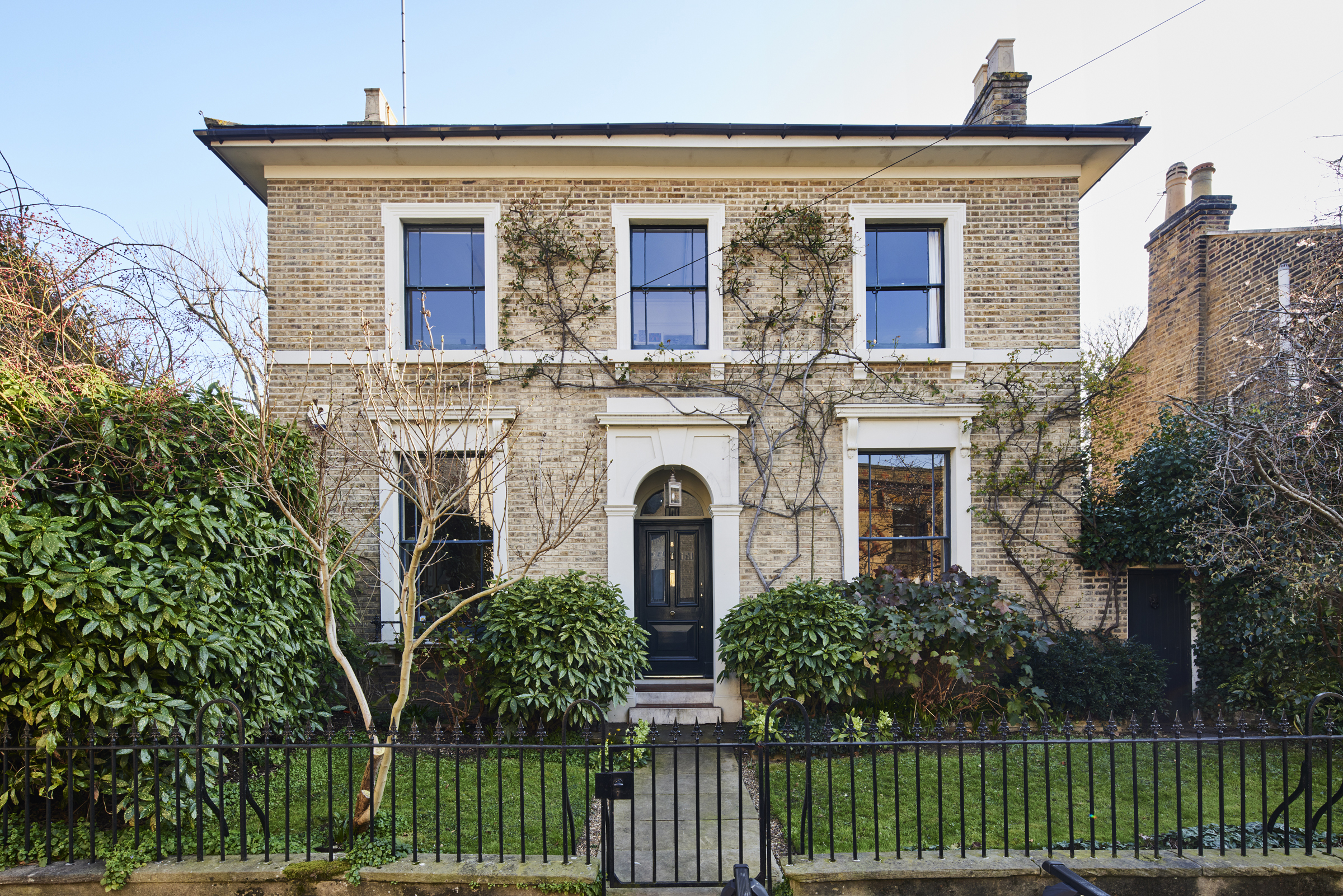The area’s links to the arts were first solidified when John Ruskin took up residence on Denmark Hill. He lived in the area for most of his adult life and wrote and painted a great deal of his works here; it is believed that his then-secretary lived in this very house on Love Walk. Today, the area retains a feeling of refined bohemianism; Camberwell Arts College is located moments away on Camberwell Church Street and noted galleries, including the Dulwich Picture Gallery, are nearby.
For more information, please see the History section below.The Grand Tour
Set back from the road, behind spearhead iron railings, a lawn with a centrally positioned path leads to the house. A lilac and winter flowering cherry tree are planted in the front garden, and climbing roses gently wind up the house’s carefully renovated brick façade. Sash windows and a grand entrance porch feature beautifully restored stucco dressings designed in the neoclassical tradition. The original panelled entrance door features inset etched glass and a roundhead fanlight above.
The spacious entrance hall bisects the house’s original plan. The living room and library are set to either side; all feature seamless waxed oak floorboards. Positioned to the rear and facing the gardens is the modern addition containing the dining room and kitchen.
The living room forms the entire depth of the original plan; it is an incredibly gracious room with wonderful proportions and original features. Double aspect windows allow the space to be flooded with light and ingenious panelled pocket door shutters offer seclusion when required. A Carrara marble chimneypiece with a working open fire acts as the centre point to the room; beautiful original plaster cornicing catches the eye. The library is home to handsome wall-to-wall joinery, hand-built and designed for the room, with a centrally-positioned bolection chimneypiece and a cosy wood burner.
The dining and kitchen area offers an exceptional contrast to the original main house. This space was one of celebrated architect Jamie Fobert’s first domestic commissions. It was designed with Viennese masterpiece the
Wittgenstein Haus’s design principles in mind, particularly evident in the elegant quadripartite fenestration to one side. Portuguese limestone with warm fawn-coloured undertones runs underfoot and extends to the exterior terrace beyond, blurring the boundary between inside and out; the interior is warmed by underfloor heating. Ceilings have been elevated to a dramatic height, with an entire expanse of wall lit from above by a glass aperture that extends the width of the room, making the perfect highlight for a favoured artwork. The kitchen is set discreetly into the rear of this space. Raised very slightly, it features an expansive custom-built steel worktop, which rests atop a row of white cupboards; open shelving is set above. A mudroom is positioned to the side, with separate exterior access and a wet room.
Ascending the staircase, there are four bedrooms and a separate bathroom. The two larger bedrooms are set to the front of the plan and enjoy a wonderful soft northern light and lovely views with mature trees in frame. One acts as the main bedroom and has handsome built-in wardrobes set on either side of the box sash window. The other large bedroom currently houses an artist’s studio with two large windows, though it could easily be converted into sleeping quarters. Two further bedrooms are positioned to the rear of the plan.
The lower-ground floor is home to a fifth guest bedroom, with its own access to the garden and a walk-in wardrobe area. There is also a large utility room, a secondary multi-purpose room and a larder-cum-wine store. This floor offers further opportunity for development if required; the floor of the bedrooms has already been lowered to create a more generous space.
The Great Outdoors
Extremely private and south-facing, the walled gardens are wonderfully mature and have an array of elegant features, with some areas designed and planted by esteemed landscape designer
Non Morris.
Two separate terraces lead from Fobert’s glorious intervention at the rear of the house. One acts as a secluded seating area and shaded outdoor dining room, while the eastern terrace leads to the lawn with a circular pond positioned centrally. A beautiful fountain with a lion’s head spout is set into the boundary wall and lends a sense of antiquity to the rear elevation.
Planting has been carefully considered and subtly added to over many years, with specimens of note including a weeping birch, apple, pear and bay trees, and two stunning magnolia trees. Flowers are abundant in the spring and summer times and a fragrant jasmine winds around the rear of the house.
Out and About
Love Walk is near Camberwell Church Street and its exciting culinary scene. Bellenden Road, Peckham’s pretty village with its excellent selection of restaurants, cafes and good pubs, is just 15 minutes walk away.
The Camberwell Arms is of particular note, as well as local favourite
Theo’s Pizzeria on Grove Lane, modern Italian restaurant
Artusi is also nearby. The newly opened Grove Lane Deli is hugely popular for provisions and there is a weekly farmer’s market on Camberwell Green.
The green spaces of Ruskin Park, Brockwell Park and Peckham Rye are all within easy walking distance, while local leisure facilities include the nearby Butterfly tennis club and Camberwell Green swimming pool. Local cultural distractions are plentiful and include the
South London Gallery and
Dulwich Picture Gallery.There are several excellent state and public schools in the area, including Dulwich College, James Allen’s Girls’ School, Alleyn’s School, The Villa Pre-Prep and Nursery, Dog Kennel Hill Primary School and Lyndhurst Primary School.
Denmark Hill station is a short walk away, running direct rail services to Victoria, Blackfriars and St Pancras International, and Overground services to Clapham Junction or Dalston Junction via Canada Water (Jubilee Line). Camberwell is also uncommonly well served by at least ten bus routes.
Council Tax Band: F
